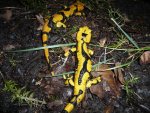tdimler
Member
- Joined
- May 7, 2007
- Messages
- 172
- Reaction score
- 9
- Points
- 18
- Location
- West Texas
- Country
- United States
- Display Name
- Travis Dimler
I am a Salamandra enthusiast but am disappointed at the lack of people interested in/keeping Salamandra here in the U.S.A. It would be beneficial for all keepers to come out of the dark and start sharing information and experiences. I would like to see this section of the forum more active. I know there have got to be more people serious into Fire Salamanders than are publically known. I understand some people like to keep to themselves but it is a shame to keep all the knowledge private.
So....I would like for everyone keeping Salamandra to check in on this thread. It would be good to know how long you have been keeping Salamandra and a general idea of what species/sub-species and localities you keep. Also...it would be nice to have a couple new discussion topics every week which receive more than one or two replies.
I'll start with both.
My current collection is:
S. s. terrestris ( Solling yellow and Solling red)
S. s. gigliolii
S. s. gallaica (Coimbra, Salvatierra, Serra de Grandola, Serra de Arrabida)
S. s. longirostris
S. corsica
I have been serious into Salamandra for about three years so most all of my stock is still too young to breed.
My question for this week is about Salamandra infraimmaculata. I would like to know the differences in type locality and physical characteristics between S. i. infraimmaculata, S. i. orientalis, and S. i. semenovi. Pehaps someone can point me in the right direction to papers which originally described them or someone who has firsthand knowledge of the complex.
It is my hope to make this a more informative forum. There are virtually no keepers of Fire Salamanders here in the U.S. (to my knowledge) and absolutely no literature in English. Some of you Europeans please chime in!
Travis
So....I would like for everyone keeping Salamandra to check in on this thread. It would be good to know how long you have been keeping Salamandra and a general idea of what species/sub-species and localities you keep. Also...it would be nice to have a couple new discussion topics every week which receive more than one or two replies.
I'll start with both.
My current collection is:
S. s. terrestris ( Solling yellow and Solling red)
S. s. gigliolii
S. s. gallaica (Coimbra, Salvatierra, Serra de Grandola, Serra de Arrabida)
S. s. longirostris
S. corsica
I have been serious into Salamandra for about three years so most all of my stock is still too young to breed.
My question for this week is about Salamandra infraimmaculata. I would like to know the differences in type locality and physical characteristics between S. i. infraimmaculata, S. i. orientalis, and S. i. semenovi. Pehaps someone can point me in the right direction to papers which originally described them or someone who has firsthand knowledge of the complex.
It is my hope to make this a more informative forum. There are virtually no keepers of Fire Salamanders here in the U.S. (to my knowledge) and absolutely no literature in English. Some of you Europeans please chime in!
Travis
Last edited by a moderator:

 Salamandra Enthusiast
Salamandra Enthusiast
